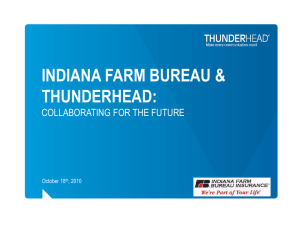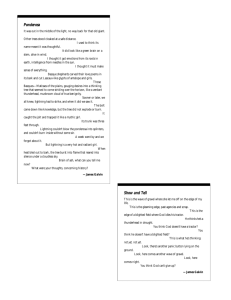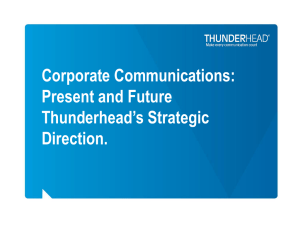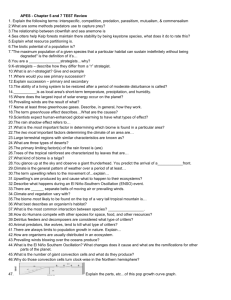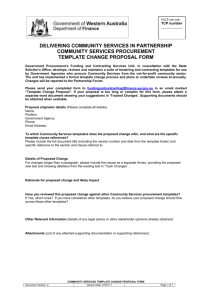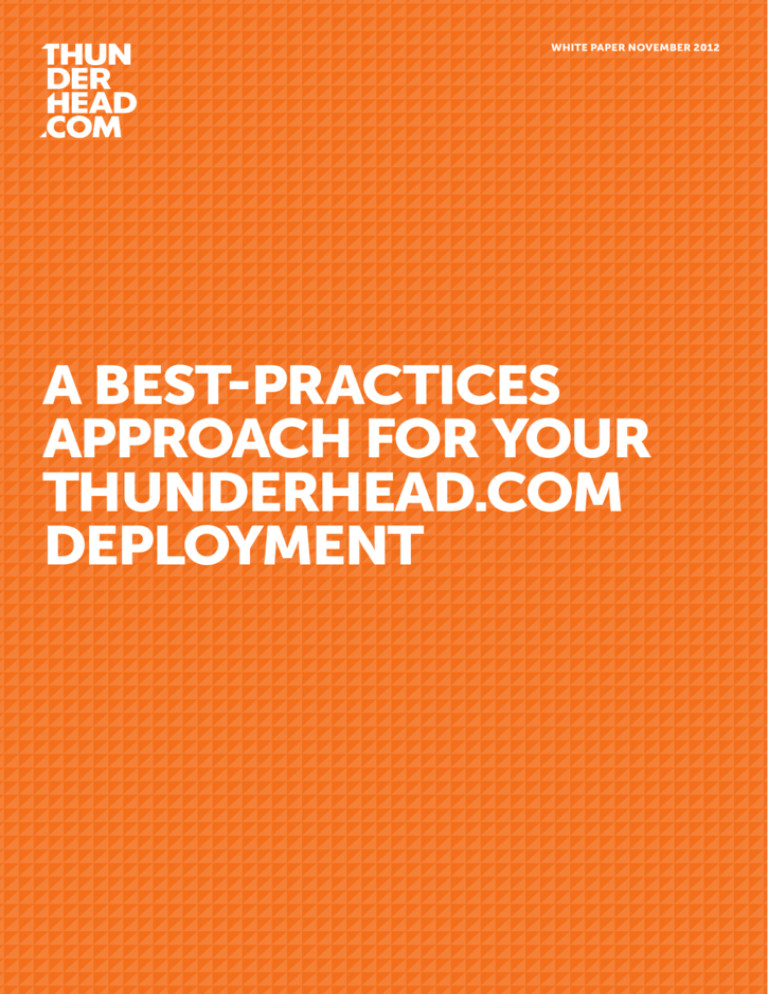
WHITE PAPER NOVEMBER 2012
A BEST-PRACTICES
APPROACH FOR YOUR
THUNDERHEAD.COM
DEPLOYMENT
WHITE PAPER A BEST-PRACTICES APPROACH FOR YOUR
THUNDERHEAD.COM DEPLOYMENT
01
INTRODUCTION
“To turn initiatives into
Defining and following best practices are
sustainable programs
important steps to getting the most value from
that continuously
your Thunderhead.com implementation.
improve and transform
It’s been shown that companies who
One approach that’s proven successful
develop standards and governance as
in many organizations is creating an
processes, business
best practices for their customer exenterprise center of excellence (COE)
process professionals
perience solutions achieve the following
for Thunderhead.com initiatives.
must establish centers of goals; they:
In this paper we’ll talk first about best
excellence (COEs) as
• Increase the effectiveness of their
practices with respect to your
especially related to Thunderhead.com implementation and
quickly as the organization solution
enterprise applications – whether
then about the benefits of creating a
can support them.”
multi-channel NOW
Thunderhead.com COE.Thunderhead.
– Alexander Peters from
Forrester Research
implementations or online SaaS
implementations
• Significantly reduce costs associated
with disparate systems and
redundancy
• Improve the overall customer
experience
But how do you ensure that the
standards and governance procedures
you’ve developed are implemented,
maintained, and deployed throughout
the enterprise?
2
com software is designed to enable
large organizations to leverage its
components across multiple channels,
business areas, and ultimately customer
experience strategies. At the same time,
we all recognize that a unified approach
to customer communications is required
in order to ensure a consistent customer
experience. For these reasons, developing
a center of excellence for your
Thunderhead.com implementations is
an appropriate strategy.
02
5 BEST PRACTICES FOR CUSTOMER
COMMUNICATIONS WITH
THUNDERHEAD.COM
Thunderhead.com provides the tools
and capabilities to help you drive
customer communications and design
and deliver a great customer
experience. Working with our
customers, we’ve identified five areas of
best practices that will help you ensure
success in your Thunderhead.com
implementation: data models, style and
branding, communication templates,
infrastructure and operations, and
business process.
Data models: It’s important to have a
solid data model for a successful
implementation. However, it’s also
important to look at how the data
models for a specific project might
apply beyond that project, including
longer-term goals. You should therefore
consider how data will be used in
communications across the enterprise,
both to ensure consistency and to allow
data from transactional events and
realtime conversations to be used in
managing the customer journey.
Style and branding: Developing a
best-practices style library in
Thunderhead.com for your overall
brand communications can help you
ensure that new documents and
projects adhere to your brand
guidelines. Styles can be defined for all
channels; web, email, SMS, and print
and can include commonly used
objects such as logos, signatures,
address information, letterhead, and
legal language, as well as support the
application of your brand tone of voice,
and so on. You can then establish
governance to make sure that deviations
from the style guide and additions to it
are managed appropriately.
Communication templates: In this
area, it’s important to consider your
long-term design goals in addition to
the template designs you’re using for
current projects. A good best practice is
to establish a subject matter expert
(SME) for template design. The SME can
then lead workshops and training
programs for anyone else in the
enterprise who will be using the
communication templates. For many
organizations, the ultimate goal is to
turn maintenance and control of
templates over to business users
as much as possible.
Infrastructure and operations:
Cross-enterprise use of Thunderhead.
com infrastructure, APIs, and
multichannel enablement is one way
you can realize cost savings with your
Thunderhead.com implementation.
Developing a COE may help to ensure
that all functional units have the
expertise they need to take advantage
of the capabilities and efficiencies in
Thunderhead.com.
Business process: Understanding and
documenting business processes and
requirements – appropriate sizing,
implementation planning, project
management, and testing procedures
– is important for business
improvement and transformation. This
is where the Professional Services team
at Thunderhead.com can help. We’ve
developed many different projects for
many different companies, and that
experience enables us to work with your
team or COEs to share knowledge and
best practices about how to transform
business processes throughout the
enterprise.
3
WHITE PAPER A BEST-PRACTICES APPROACH FOR YOUR
THUNDERHEAD.COM DEPLOYMENT
03
CONSTRUCTING A COE TEAM FOR
YOUR THUNDERHEAD.COM
IMPLEMENTATION
As we alluded to above, it’s one thing to
develop a set of best practices for the
organization to follow. It’s quite another
thing to make sure those best practices
are followed, maintained, and, where
appropriate, revised or discarded.
Centers of excellence can help your
organization achieve those goals.
For example, companies that commit
themselves to delivering a great
customer experience know that they
must not only develop best practices
around customer experience but make
sure that every person embraces them
and every process is aligned to it.
Centers of excellence can be used quite
effectively to define customer
experience strategies, set standards, and
promote best practices.
Technically speaking, centers of
excellence are usually small, crossfunctional teams or groups that
establish and maintain a set of
procedures to ensure that the larger
organization can meet its strategic
goals. Connie Moore from CIO
Magazine suggests that to be most
effective, companies should create
COEs that are “small and nimble, and
replicate them throughout the
organization.”1 When building a COE
team, you will likely want to fill a
number of roles. This team must not
only understand best practices for a
Thunderhead.com implementation,
they will also be responsible for
understanding your organization’s vision
with respect to customer
communications (and customer
experience management).
4
Typical areas of responsibility we’ve
seen in successful COEs include the
following:
• New project sizing and risk assessments
• Data model and integration best practices
• Template best practices and brand
governance
• Multichannel standards (with
responsibility for output and print
vendor management)
• Quality assurance guidelines
Although it’s common for the COE itself
to be managed within IT, members of
the COE team often come from
different areas within the organization,
including key business owners and
stakeholders in marketing, compliance,
support, and customer service. This
approach can ensure that the COE is
responsive to the business while helping
to drive standards and governance.
Engaging all departments is especially
important when the purpose of the COE
is to implement a broad strategic goal,
such as delivering a consistent, best-inclass customer experience
04
LEVERAGING YOUR INVESTMENT TO
DEVELOP A GREAT CUSTOMER
EXPERIENCE
As some enterprises are discovering,
COEs are not merely helpful for
developing and maintaining standards,
these small agile teams can actually
transform the larger organization.
According to Alexander Peters from
Forrester Research,
To turn initiatives into sustainable
programs that continuously improve
and transform processes, business
process professionals must establish
centers of excellence (COEs) as
quickly as the organization can
support them.
Continuous improvement is certainly a
worthy goal, but sometimes wholesale
transformation is needed. One area
where that is often true today is the way
in which many organizations handle
customer communications and
ultimately the customer experience.
Unlike Apple (a company that obsesses
about customer experience in every
detail, at every touch point, in every
communication), many businesses
today offer their customers a
fragmented or disjointed experience.
The web experience is disconnected
from the retail experience, online
support is different from phone support,
email and print communications are not
related, and so on.
In its report, “The Customer Experience
Index, 2012,” Forrester found that
customers rated only 37% of the
companies they do business with as
good or excellent. Nearly two-thirds
received a rating of OK, poor, or very
poor. Customers described experiences
such as “going to a store, only to be sent
to a website, then to interactive chat
and a phone call, to end up with a paper
form to sign.” Customers, says Forrester,
“are tired of it.”
This fragmentation is why many
organizations have turned to customer
experience management (CEM). They
recognize that customer experience is
the responsibility not solely of the
marketing department, but of the entire
enterprise. They also recognize the
important role that technology – and
thus, the IT department – will play in
ensuring that every touch point with the
customer is considered and integrated.
Which brings us back to centers of
excellence and Thunderhead.com.
Thunderhead.com offers enterprise
solutions that improve the way
businesses engage with their customers.
These solutions help organizations
maintain consistent conversations and
communications across all channels,
from print to digital (web, mobile, and
social) to the call center. Creating a COE
around your Thunderhead.com
implementation then allows you to steer
the entire organization toward one goal:
creating a stellar experience for your
customers.
WE’RE HERE TO HELP
Setting up a center of
excellence may be a new
experience for some of
our customers, and we’re
happy to help with that.
Our team at Thunderhead.
com is available to
conduct a best practices
workshop with your
organization and then
work with you to establish
a COE tailored to your
business. Please contact
us to learn more:
customersuccess @
thunderhead.com
Imagine that you had this kind of
pervasive dedication to your customers’
needs across your enterprise. With the
support of a customer-focused COE
you could continuously improve the
experience in every conversation. You
could deliver exactly what consumers
want, every time. Companies that
deliver this superior customer
experience outperform the status quo
to drive customer loyalty, competitive
advantage, improved brand health and
increased revenue. Aligning an
enterprise around creating a
phenomenal customer experience is the
kind of transformation that COEs are
designed to enable.
5
WHITE PAPER A BEST-PRACTICES APPROACH FOR YOUR
THUNDERHEAD.COM DEPLOYMENT
APPENDIX 1. BEST PRACTICES
EXAMPLES
One of the hallmarks of Thunderhead.com
is the ability to reuse and repurpose as
much content as possible. Benefits of
reuse include:
PROJECT 1
TEMPLATE A
TEMPLATE B
STYLESET
LAYOUT X
• Greater consistency across
communications
SHARED CONTENT
• One central location for updates, so
that one change will update all
related communication.
SHARED CONTENT
BUSINESS OBJECT
TEMPLATE C
LAYOUT Y
SHARED CONTENT
• Ability to manage and view the
impact of any change made to
content that is common between
communications
In order to maximize the benefit of
shared content, Thunderhead.com
makes the following recommendations.
TEMPLATE D
LAYOUT Z
Each of the graphics in this section
represents an example of the types of
best practices typically governed by a
COE. Detailed guidelines documented
in a standards manual increase
effectiveness while also reducing the
learning curve for new team members.
PROJECT MANAGEMENT AND
RELEASE STRATEGIES
Best Practices for project release cycles
should include a design which models
the change cycle of the business. A
business change may for example require
changes to five templates, four pieces of
shared content, and a layout. All of these
items should be checked-out to the
project to allow the change to be made.
The document templates will themselves
point to released versions of other
resources – for example, a released
styleset or a released piece of shared
content. These do not need to be part
6
SHARED CONTENT
of the project as they do not form part
of this business change.
In the Project A diagram example, some
of the resources (with red ticks) are ready
for release before other resources in the
project. Best practices project
management procedures should allow
for separate projects to be created to
enable individual resources to be moved
forward while leveraging Thunderhead.
com’s built-in project management,
approval workflow, and security.
SHARED CONTENT, STYLESETS,
AND LAYOUTS
Standard stylesets and layouts to support
company branding are an important
area for governance. We recommend
publishing a style guide for all
Thunderhead.com communication to
ensure adherence to the corporate brand
as well as best practices for maintenance.
Create shared content only when it is
ready to be shared
Thunderhead.com’s shared content
concept is a key factor in efficient
document creation and reducing the
overall cost of maintenance. Shared
content should only be created when it
is needed and when all of the data items
that need to be populated within it are
available. While it is tempting to create
shared content as soon as the static
content is ready, it is best to wait until it
is populated with data items or assembly
rules, so that when it is imported into a
template, the list of data items is created
automatically. These data items can be
set after the shared content is created,
but it is much faster to do this after the
data and rules have been created.
Here are some initial questions to answer
to help facilitate a best practices review
session where Thunderhead.com
Professional Services will assist your
organization with standards and
governance leveraging a COE.
multiple stages of approval from
multiple groups and/or users), according
to specifications.
The approval workflow functionality in
Thunderhead.com’s Approve NOW
features:
• Multiple workflows per project
• Workflow design functionality that
enables sophisticated workflow routing
• Parallel approval
• Group-based approval, in addition
to approval by named individuals
• An Inbox showing all items awaiting
approval
• Collaborative annotation
Create inline shared content for
common phrases which vary by a
business rule
Inline shared content is simply shared
content that uses the Inherit style to
inherit its formatting from the parent
document template. This can be
extremely useful for applications where
there are common words and phrases
which must be controlled by business
rules. For example, a piece of inline
shared content might be created which
displays:
For questions, call Customer Service
– Telephone: 1-800-555-1234
This could be utilized in many documents,
providing for easy maintenance and a
single point of update.
Use variable data by value, rather
than by business object reference
Passing variable data by value is the
default and allows multiple document
templates to use the same shared
content. For example, an address block
might have input data for AddressLine1
through AddressLine6 and be used by
many document templates. If it were set
up using business object references
from within the shared content, it would
only be reusable in document templates
which use exactly the same business
object. If you pass the data as
arguments, the shared content can be
used with many different business
objects.
USERS, SECURITY, AND APPROVAL
LEVELS
All elements of the Thunderhead.com
platform (modules, tasks, processes,
screens, etc.) are securely controlled
using the principle of group-level
access. Each time a request is made to
use a particular resource, the grouplevel access attributes are checked
against those marked on the resource.
Defining standards is key for enterprise
implementations. In addition, defining
best practices for simple and complex
workflows will ensure consistent
efficiency within the organization.
For example, workflows can be simple
(taking entire projects directly from a
state of development to a state of “ready
for release”) or complex (involving
• Target completion indicators, which
show at a glance which items in a
workflow case require the most
urgent review
• Synchronization with external third-party workflow systems, via
the Thunderhead.com NOW API.
•
Workflow cases are started from the
Projects tab and are managed
in Thunderhead.com Admin,
via the Approval Workflows tab
and the Inbox.
7
WHITE PAPER A BEST-PRACTICES APPROACH FOR YOUR
THUNDERHEAD.COM DEPLOYMENT
FORMS MANAGEMENT DESIGN AND
META DATA
Best practices for forms management
design are important especially when
taking full advantage of the complex
selection criteria.
You can use resource categories with
API calls such as searchCMSByResourceCategory. You can also use
resource categories from within Business
Content Studio to retrieve shared content
or to retrieve enclosures.
Typically attachments are selected by
multiple criteria such as line of business,
state jurisdiction, effective date,
commercial versus personal, etc.
Standardizing the API calls for multiple
business areas to leverage becomes a
reusable asset best governed by a COE.
However, consider the scenario where
you have a large repository of forms that
have metadata within resource categories
that define perhaps 20 to 30 different
metadata items. You could use any
combination of those metadata fields to
retrieve specific sets of templates or
enclosures.
8
RISK MANAGEMENT AND QUALITY
ASSURANCE
A final example of the types of best
practices recommended for central
governance are templates to help
project managers follow proven
methodologies for risk management
and quality assurance. These templates
are built upon years of experience
implementing complex projects in
enterprise architecture environments.
The templates include:
• Architecture sizing tools
• New project scope inventory and
effort assessments guidelines
• Unit, system, and integration test
plan templates
• Project plans for high-quality, low
risk, iterative development
•
Risk management considerations for various project types including
multi-channel batch, real-time, web
portal integration, and highly
sophisticated interactive documents.
APPENDIX 2. CUSTOMER SURVEY:
GETTING STARTED WITH A BEST
PRACTICES REVIEW
Here are some initial questions to answer to help facilitate a best practices review session where
Thunderhead.com Professional Services will assist your organization with standards and governance
leveraging a COE.
BUSINESS OBJECTS AND XML SCHEMAS
Ref#
Details
BOXML1
How many business objects are being utilized in the Thunderhead.com environment?
BOXML2
What are the main factors for usage of multiple business objects?
For example: feeding systems, applications, communication types.
BOXML3
Is there common data across all business objects?
For example: an address class, etc.
BOXML4
Is all business object creation and maintenance facilitated through an XML schema
(XSD file)?
BOXML5
Does the schema(s) reflect any common domain level data?
For example: a recipient schema used to define a commonly used recipient class.
BOXML6
Is data organized into domain level classes and template specific classes?
For example: data common to all communications in a set of classes and templatespecific data organized into further classes.
BOXML7
Is all data strongly typed?
For example: monetary amounts defined as integer data types as opposed to strings.
BOXML8
Is the naming convention of data items “template author” friendly?
For example: X101_Dt vs Policy_Modification_Date.
BOXML9
Are enumerations being used where appropriate?
(Enumerations should be used, where possible, for all data items that have a
predefined list of possible values. This mitigates risk of template authors incorrectly
coding assembly logic.)
BOXML10
In the case of large data models, are views being used?
(Views can limit how much of the entire data model is visible to template authors, thus
improving usability.)
9
WHITE PAPER A BEST-PRACTICES APPROACH FOR YOUR
THUNDERHEAD.COM DEPLOYMENT
DATA MANIPULATION AND AMALGAMATION
Ref#
Details
DATMA1
Are derived properties being populated with SQL queries out to external data sources?
If so, approximately how many derived properties are being populated this way?
DATMA2
To what extent are derived properties being used and, in general, for what purpose?
Could the data manipulation be handled further upstream – for example, by the extract
program or existing ETL layer?
SAMPLE DATA
Ref#
Details
SMPLD1
Does a library of sample data exist for template authors?
SMPLD2
To what extent are derived properties being used and, in general, for what purpose?
Could the data manipulation be handled further upstream – for example, by the extract
program or existing ETL layer?
Do all business object updates, including development of derived properties get tested
with sample data?
SMPLD3
Do template authors have the necessary XML skill set to update Thunderhead.com
sample data to facilitate unit testing assembly logic?
CMS ORGANIZATION
10
Ref#
Details
CMSOR1
Are Thunderhead.com resources being organized by type?
For example: folders for sample data, folders for shared content, config files, etc.
CMSOR2
Is there a client-specific domain structure in place representing application or line of
business?
CMSOR3
Does the folder structure lend itself to easily facilitate the propagation of security
permissions?
CMSOR4
Is the naming convention intuitive for folders and the contained resources?
CMSOR5
Are keywords or descriptions being assigned to resources to aide locating of resources?
CMSOR6
Does the CMS folder structure represent ownership of content?
For example: shared content owned by a specific business group organized as such to
facilitate ease of assigning permissions so that only the appropriate group can edit the
shared content resources.
PROJECT USAGE
Ref#
Details
PROJCT1
Are individual projects used by multiple developers for collaboration?
PROJCT2
Does project usage reflect an actual project or program of work being conducted?
PROJCT3
Does project usage reflect a collection of related items of work that must be
completed on or near the same date?
PROJCT4
What are the development processes with regards to project migration into testing
and production environments?
PROJCT5
What are the development processes with regards to project rollback?
PROJCT6
Is the enterprise licensed for Approve NOW? If so, are Approve NOW workflows
being used?
STYLESETS
Ref#
Details
STYLST1
Is the styleset naming convention intuitive and a reflection of the style’s use rather
than its characteristics?
For example: Body_Header vs. Arial_14pt_Bold.
STYLST2
Are styles being used appropriately across all channels?
For example: Body_Header defined across all channels vs. Body_Header_Print and
Body_Header_Email.
STYLST3
Are styles being used to control paragraph related white space?
For example: space-after attribute being used vs. carriage returns in the fragments.
STYLST4
Are widow/orphan controls being used to prevent content breaking inappropriately
across pages?
STYLST5
Are table styles being used according to best practices?
For example: definition of row/cell styles etc., that are then referenced by a parent
table style. Also the design of the styleset should separate the formatting of table
cells into typeface-oriented attributes (font-family, line-height, font-weight) and cell
box attributes (borders, background-color, etc.). For example, you might create a
styles tableBody and cellStyle and use tableBody across all of your table cells for the
character formatting and use the cellStyle to present lines around the edge or
background shading. Using this approach allows box formatting to be changed
independently of the character formatting which can save time later when you need
to add table heading or totals style.
STYLST6
Is text transformation being handled by an inline style where appropriate?
For example: using uppercase attribute to transform a string data value to uppercase.
11
WHITE PAPER A BEST-PRACTICES APPROACH FOR YOUR
THUNDERHEAD.COM DEPLOYMENT
SHARED CONTENT
Ref#
Details
SHDCN1
Is shared content being used liberally?
SHDCN2
Has shared content been created using generic arguments (not tied to specific
business object classes) to define its arguments?
SHDCN3
In the case of shared content created using anything other than the generic method
of defining arguments mentioned above, is the entire business object being passed to
the shared content? Or a specific class?
SHDCN4
Has nested shared content functionality been taken advantage of?
For example: Nesting three address-related shared content resources into a single, all
encompassing, address-shared content.
SHDCN5
Are commonly used business phrases, phone numbers, etc., being created as inline
shared content?
SHDCN6
Is all inline shared content style-agnostic?
For example: all content set to “Inherit” style.
SHDCN7
Has consideration been given to using shared content to provide a template library for
content too dynamic to qualify as traditional shared content?
DDVS
12
Ref#
Details
DDVRV1
Has rationalization been conducted on the DDVs?
DDVRV2
Do DDV “templates” exist?
For example: a resource that a copy can be made of to accelerate the development
process. The template contains the defined channel, business object argument,
styleset references, etc., as well as any regions of the documents that are always
reused, such as the address or header sections.
DDVRV3
How extensive is the use of repeated document-level scripting across DDVs? Could
this be created as functions within a function library?
DDVRV4
Are DDVs well organized and structured with regards to the usage of sections and
fragments?
ASSEMBLY LOGIC
Ref#
Details
ASLGC1
Has assembly logic been implemented according to coding best practices?
For example: appropriate use of parenthesis, appropriately nested logic, etc.
ASLGC2
Has advanced assembly logic been implemented where appropriate?
For example: “when” statements vs. repeating “if, else if” statements.
ASLGC3
Has advanced content been implemented where equivalent functionality could have
been achieved with the use of shared content?
ASLGC4
Is inline logic being used to mitigate the need for repeating high percentages of text
across fragments?
ASLGC5
Could assembly logic around enclosures or shared content links be reconstructed to
take advantage of dynamic enclosures and/or dynamic shared content?
MULTICHANNEL ENABLEMENT
Ref#
Details
MLTCH1
Is the enterprise making use of Thunderhead.com’s multichannel capabilities?
MLTCH2
If so, are single DDVs being used for multichannel communications?
For example: one DDV configured to output content to print and email.
MLTCH3
Are fragment editions and content to region mappings being used to appropriately
vary the content across delivery channels?
MLTCH4
Has the shared content library also been configured to reflect the multichannel
configuration?
For example: a single piece of shared content for the company logo, with two
channel-related editions vs. two separate pieces of shared content, each housing a
version of the company logo.
MLTCH5
Are channel job properties being used to pass post rendering processing related data
to the appropriate channel output?
13
THUNDERHEAD NOW
LEADING THE WAY IN CUSTOMER COMMUNICATIONS MANAGEMENT
ABOUT THUNDERHEAD.COM
Thunderhead.com is a leading provider
of enterprise solutions for customer
experience management. The
Thunderhead.com ONE customer
engagement platform provides
powerful SaaS solutions that
fundamentally change the way
businesses engage with each other and
their customers. Some of the world’s
most demanding companies trust
Thunderhead.com to help them build
customer engagement and create
enduring relationships. With
Thunderhead.com, businesses have
more power to drive revenue, brand
strength, and differentiation through
superior customer experience.
Thunderhead.com serves its global
customer base from offices located in
North America, Europe and Asia Pacific.
See: www.thunderhead.com
info@thunderhead.com
Copyright © Thunderhead 2009. All rights reserved. Version 1.0 (UK). Thunderhead endeavours to
ensure that the information within this document is correct and fairly stated, but does not accept any
liability for any errors or omissions.

